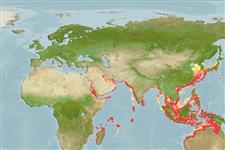Common names from other countries
Environment: milieu / climate zone / depth range / distribution range
Ecología
; rango de profundidad 30 - 120 m (Ref. 275). Tropical; 41°N - 24°S, 32°E - 143°E (Ref. 275)
Indo-West Pacific: from Mozambique to Red Sea and Japan.
Length at first maturity / Tamaño / Peso / Age
Maturity: Lm ? range ? - ? cm Max length : 10.0 cm ML macho / no sexado; (Ref. 275); peso máximo publicado: 400.00 g (Ref. 275)
A small to moderate-sized species recognized by a distinctive color pattern consisting of large, light-colored round patches, separated by dark reticulations over the entire dorsal surface. There is also a light cream-colored longitudinal stripe along the dorsal midline of the mantle.
Maximum total length is 30 cm. Supports subsistence fisheries in East Africa (Ref. 3722). Found in sand and muddy sand areas. Inhabits holes and defends its turf. Solitary with crepuscular behavior (Ref. 101169). Benthic. Inhabits the continental shelf (Ref. 9773).
Life cycle and mating behavior
Madurez | Reproducción | Puesta | Huevos | Fecundidad | Larva
Members of the class Cephalopoda are gonochoric. Male and female adults usually die shortly after spawning and brooding, respectively. Mating behavior: Males perform various displays to attract potential females for copulation. During copulation, male grasp the female and inserts the hectocotylus into the female's mantle cavity where fertilization usually occurs. Life cycle: Embryos hatch into planktonic stage and live for some time before they grow larger and take up a benthic existence as adults.
Roper, C.F.E., M.J. Sweeney and C.E. Nauen. 1984. (Ref. 275)
IUCN Red List Status (Ref. 130435)
CITES status (Ref. 108899)
Not Evaluated
Not Evaluated
Human uses
Pesquerías: comercial
| FishSource |
Herramientas
Fuentes de Internet
Estimates based on models
Preferred temperature
(Ref.
115969): 18.2 - 28.3, mean 27 (based on 733 cells).
Vulnerability
Low vulnerability (10 of 100).
